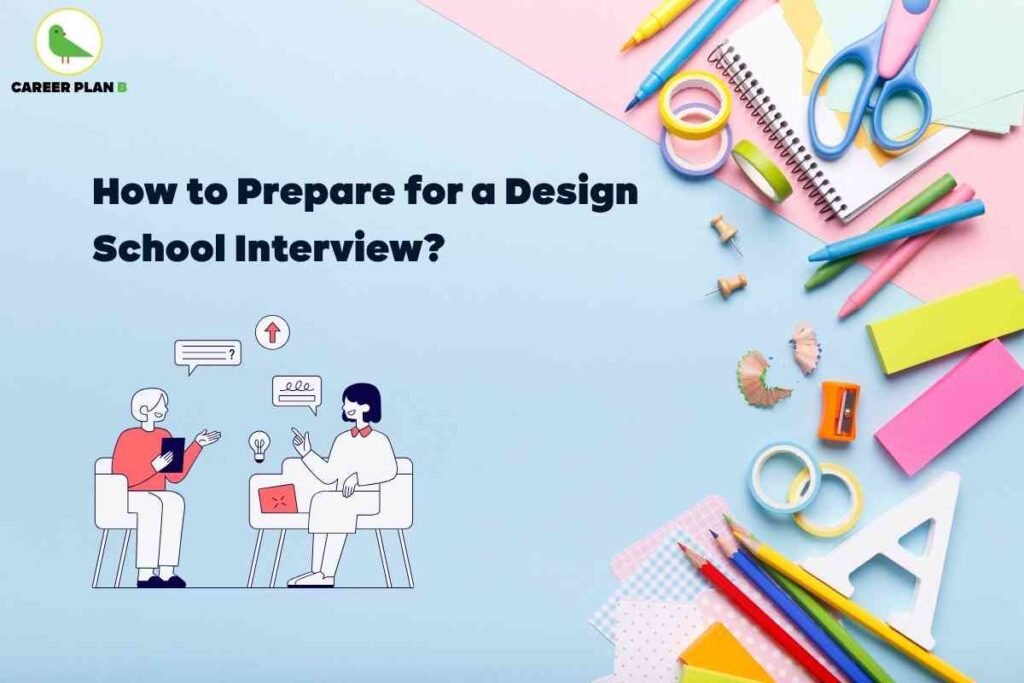Introduction
Design school interview preparation is the key to turning your shortlist into a coveted admission. Getting called for a design school interview is an achievement, but the true challenge lies ahead: presenting your personality, creativity, and clarity of thought before a panel of experts. These interviews assess far more than just skill—they test your passion, process, and potential. Whether you’re applying to top institutes like NID, NIFT, MIT Institute of Design, UID, or Pearl Academy, interviewers expect excellence. This blog provides proven strategies and insights from industry experts to help you ace your design school interview and showcase your best self.
Why Design School Interviews Matter
Unlike academic interviews that focus on marks and theories, design school interviews emphasize creativity, thinking process, self-awareness, and communication. Your performance here can make or break your admission, even if you aced the entrance exam or studio test.
Interviewers want to understand:
- Why you chose design as a career
- How you think creatively and solve problems
- What kind of learner and designer you are
- Whether you are a good fit for their pedagogy and culture
The Purpose of the Design School Interview
Before you start preparing, it’s essential to understand what the interview panel is looking for. They want to assess:
- Your Passion: Are you genuinely enthusiastic about design?
- Your Creativity: How do you think and approach problems?
- Your Self-Awareness: Do you understand your strengths and weaknesses?
- Your Teachability: Are you open to learning and receiving feedback?
- Your Fit: Do your goals align with the philosophy and offerings of the institute?
The interview is a conversation designed to uncover these qualities.
How to Prepare for a Design School Interview
1. Understand the Institute’s Philosophy
Every design school has its own philosophy. For example, NID emphasizes design thinking and innovation, while NIFT may stress industry relevance and fashion trends.
Tip:
- Read their program structure, faculty background, and past student work
- Understand what makes the school unique and prepare accordingly
2. Prepare Your Design Portfolio (If Required)
Some interviews require a portfolio, while others might not. But if you’re asked to bring one, make it your strongest asset.
Portfolio Guidelines:
- Include 8–12 original works (sketches, digital work, photography, product ideas, etc.)
- Show process: research, ideation, prototyping
- Explain each project with a short description and the “why” behind your choices
- Keep it clean, organized, and professional
3. Know Your Design Journey
Common Questions:
- Why do you want to be a designer?
- Who inspired you to choose this path?
Which design field interests you the most (fashion, product, UI/UX, etc.) and why?
Your answers should reflect honesty and self-awareness. Don’t give cliché answers. Show how you’ve grown through projects, competitions, or personal exploration.
4. Practice Common Interview Questions
Here are some frequently asked design interview questions and how to approach them:
| Question | What They’re Looking For |
|---|---|
| Tell us about yourself. | Confidence, clarity, personality |
| Why design? | Motivation, passion, background |
| Which designers or artists do you admire? | Awareness of design culture |
| What is your favorite design project and why? | Thought process, problem-solving |
| What would you do differently in that project? | Ability to critique your work |
Tip:
Write your answers, rehearse with a mentor or friend, but avoid sounding scripted.
5. Brush Up on Design Basics
Even if you’re not expected to be an expert, you should know the basics of:
- Design elements (line, color, shape, space)
- Principles (balance, contrast, hierarchy, rhythm)
- Current design trends in your chosen field
- Famous designers and their work
This shows that you are genuinely interested in learning and have done your homework.
6. Prepare Questions to Ask the Interviewer
When the panel asks, “Do you have any questions for us?”, don’t say “No.”
Ask smart questions like:
- “How does this program encourage industry exposure?”
- “What kinds of collaborative projects do students work on?”
- “How is the feedback process structured?”
This shows your engagement and maturity.
7. Work on Your Communication & Body Language
Design interviews are often conversational and informal, but they still expect professionalism.
Tips:
- Be polite, calm, and enthusiastic
- Sit upright, maintain eye contact
- Smile when appropriate
- Don’t interrupt panelists
- Avoid jargon or overusing buzzwords
8. Dress Smart, Stay Comfortable
There’s no need to wear formal suits, but also avoid too casual or flashy clothes.
Dress Code Tip:
- Opt for neat, semi-formal attire that reflects your personality
- Wear something that makes you feel confident
Common Design Interview Questions & How to Answer Them
Be prepared to answer a mix of personal, technical, and creative questions.
Personal and Motivational Questions
- “Why have you chosen this specific design field (e.g., fashion, graphic, product)?”
Connect your personal interests and skills to the specific discipline. For example, if you’re applying for graphic design, talk about your love for visual storytelling and communication. - “What are your biggest strengths and weaknesses?”
For strengths, choose qualities relevant to a designer (e.g., creativity, attention to detail, empathy). For weaknesses, be honest but frame it positively. Name a genuine area for improvement and explain what you’re doing to work on it. - “Where do you see yourself in five years?”
Show that you have clear career ambitions. Talk about the kind of work you hope to be doing and explain how studying at this particular institute is the crucial first step in your plan.
Design and Industry Awareness Questions
- “Who is your favorite designer, and why?”
Choose a designer whose work genuinely inspires you. Go beyond the name and analyze their aesthetic, their impact on the industry, or their innovative techniques. This shows a deeper level of critical thinking. - “What are some current design trends that interest you?”
This tests your industry awareness. Be specific. Mention a trend, discuss its origins, and offer your opinion on it. This proves you are engaged with the contemporary design world. - “What, in your opinion, constitutes ‘good design’?”
There is no single right answer. This question assesses your design philosophy. A strong answer might touch upon functionality, aesthetics, user experience, and sustainability, showing a well-rounded understanding of design principles.
Do's and Don'ts for the Interview Day
| Do’s | Don’ts |
|---|---|
| Dress Thoughtfully Your outfit should be neat and professional but also reflect your personal style. |
Argue with the Panel It’s okay to have a different opinion, but express it respectfully. Avoid being confrontational. |
| Be Punctual Arrive on time, whether the interview is in-person or online. Punctuality shows respect. |
Lie or Exaggerate Be honest about your skills and experiences. Authenticity is more impressive than false claims. |
| Maintain Eye Contact Engage with all the interviewers. It projects confidence and keeps them involved. |
Use Filler Words Avoid “um,” “ah,” and “like.” Speak clearly and confidently. It’s okay to pause to gather your thoughts. |
| Ask Insightful Questions Prepare a few questions for the panel about the course, the culture, or student life. |
Forget Your Portfolio Have your portfolio ready and be prepared to discuss every single piece within it. |
| Listen Actively Pay close attention to the questions and answer what is being asked. |
Be Negative Avoid criticizing other design schools, designers, or your own past work. Stay positive. |
Final Interview Preparation Checklist
Research the institute’s vision and program structure
Prepare thoughtful answers for common questions
Build a clean, organized portfolio (if required)
Practice speaking about your projects
Review design basics and trends
Prepare questions to ask the panel
Check your outfit and presentation materials
Get a good night’s sleep before the interview
FAQs About Design School Interviews
Q: Do I need to be an amazing artist or sketcher to get in?
A: While drawing skills are helpful, colleges are primarily looking for creativity, original ideas, and a unique perspective. Your ability to think like a designer is more important than your technical drawing skill.
Q: What if I get nervous and freeze up?
A: It’s normal to be nervous. Take a deep breath. If you need a moment to think, it’s perfectly fine to say, “That’s a great question, let me take a moment to think about that.”
Q: What should I do after the interview?
A: Sending a brief, polite thank-you email within 24 hours is a professional gesture that reinforces your interest in the program.
Conclusion: Show Your Creative Self
A design school interview is your moment to express not just your artistic abilities, but your thinking style, commitment, and passion for the field. It’s less about right or wrong answers and more about presenting your authentic self as a learner and future designer.
Come prepared, be confident, and remember — design is about solving problems creatively, and this interview is just the first one you’ll solve as a future designer.
At Career Plan B, we offer:
- Mock interviews tailored to design roles
- Portfolio coaching to refine storytelling and visual flow
- Feedback on communication and personal branding
- Insights into industry company cultures and interview practices
Book Your Free Design Interview Strategy Call Today. Talk to Our Design Mentors



